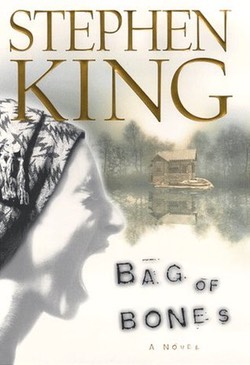What scares Stephen King? That question has been asked in hundreds of interviews and articles about the author, but the answer is easy. What scares Stephen King? Tom Clancy.
In early 1997, publishers Penguin and Putnam merged and suddenly Tom Clancy and Stephen King were under the same roof. Viking, a subsidiary of Penguin, had been King’s publisher since The Dead Zone, their relationship running to over 30 books, but King’s star had been slipping.
In the old days, his books stayed on the New York Times bestseller list for 35 weeks (Firestarter, It, The Stand complete edition), 32 weeks (Pet Sematary), or 28 weeks (Gerald’s Game). But since 1993 they’d been slipping. Dolores Claiborne only lasted 14 weeks, and the same for The Regulators and Rose Madder. Insomnia lasted 16 weeks. Desperation made it to 15. King’s sales had plateaued at 1.2 million copies. That’s not so bad, but when you’re demanding advances of around $16 million those numbers don’t work. One publisher who tried to negotiate with King at the time said, “I have no problem with building up a superstar author where everybody makes money. But to be forced to pay top dollar so you basically can make no money?”
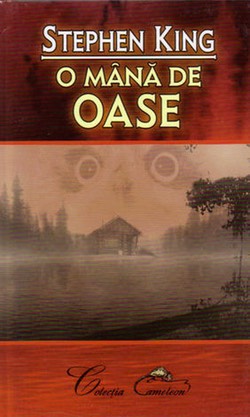 Clancy sold more books and made more money than King which meant he was more important to Penguin Putnam. He had just negotiated a brand new mega-deal. The head of the company, Phyllis Grann, had helped build Clancy’s career. King didn’t have the juice or the connections that Clancy did in the new company, and so, with Bag of Bones, he left his publisher of 20 years and landed at Scribner. He says the move “rehabilitated my reputation.” And he did it by writing his most old fashioned book of all.
Clancy sold more books and made more money than King which meant he was more important to Penguin Putnam. He had just negotiated a brand new mega-deal. The head of the company, Phyllis Grann, had helped build Clancy’s career. King didn’t have the juice or the connections that Clancy did in the new company, and so, with Bag of Bones, he left his publisher of 20 years and landed at Scribner. He says the move “rehabilitated my reputation.” And he did it by writing his most old fashioned book of all.
It’s easy to forget that the amiable author with his “Aw, shucks” demeanor didn’t become one of the world’s best-selling writers through lack of ambition, and he’s never been one to hide his grudges. “I was squeezed out at Viking, because Phyllis Grann came from Putnam, and she brought with her Tom Clancy, who sold more books than I did,” he said in an interview with TIME. Clancy sold 2.4 million copies of his 1996 book Executive Orders, and his new deal at Penguin Putnam was worth around $20 million per book, with added online gaming ventures that edged the deal towards $100 million. King’s goal with Bag of Bones was clear, “I wanted to knock Tom Clancy out of the No. 1 spot.”
So when King submitted a draft of Bag of Bones to Viking in September of 1997, the writing was on the wall. King wanted $18 million for the book, and a higher royalty rate. Viking wasn’t biting. So, while Viking still believed themselves to be “in negotiations,” King’s lawyer sent a letter to various publishers stating, “We’re contacting a small group of publishers and are indicating to them that Mr. King is looking to establish another longstanding relationship, which will be artistically and financially beneficial to all parties.” Many meetings were had, but not with King. His lawyer conducted them while his author was on a motorcycle trip across Australia.
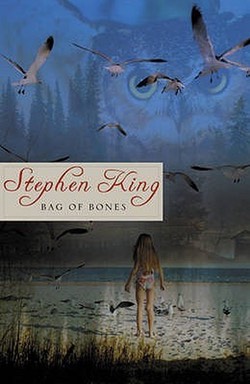 No one could justify $18 million at the numbers King was selling, but his lawyer responded with a tricky bit of circular reasoning, stating that any new publisher would be expected to do a marketing push that would raise King’s readership, so the price tag was worth it. In the end, King went for ego over cash, heading to the posh literary house of Scribner, home of Ernest Hemingway and Edith Wharton, for a $2 million advance and a profit-sharing royalty of 55/45 in his favor. If he couldn’t make more money than Clancy, he would be more literary. But the negotiations were awkwardly public and they made King look greedy. “I never should have asked for all that money,” he later said in an interview. “It was so stupid…a bad move…If I could do it all over again, I’d have asked Scribner for a dollar a book.”
No one could justify $18 million at the numbers King was selling, but his lawyer responded with a tricky bit of circular reasoning, stating that any new publisher would be expected to do a marketing push that would raise King’s readership, so the price tag was worth it. In the end, King went for ego over cash, heading to the posh literary house of Scribner, home of Ernest Hemingway and Edith Wharton, for a $2 million advance and a profit-sharing royalty of 55/45 in his favor. If he couldn’t make more money than Clancy, he would be more literary. But the negotiations were awkwardly public and they made King look greedy. “I never should have asked for all that money,” he later said in an interview. “It was so stupid…a bad move…If I could do it all over again, I’d have asked Scribner for a dollar a book.”
Scribner went all-in on Bag of Bones, both to soothe King’s ego and to get a return on their investment. Their first printing was 1.36 million copies, they issued 9,000 ARCs (advanced reader copies), they sent bookstores a cassette of King reading from BoB, and gilded it with highbrow blurbs from literary heavyweights like Amy Tan. They took out billboards, published a special edition Stephen King magazine, ran commercials in Blockbuster video stores (owned by Scribner’s parent company, Viacom), and they made BoB the only hardcover fiction they released that September. Their press release called it a “haunted love story” and didn’t mention horror once, touting King as an “O. Henry Award-winning author.” This wasn’t just to appeal to his vanity. Scribner had hired focus groups who spent four nights analyzing why readers were leaving King. Their major finding was that female readers were abandoning the author in droves because he was seen as a horror writer.
Bag of Bones, with its emphasis on romance, is King’s attempt to appeal to a market where the majority of readers were women (who had made another of his rivals, Anne Rice, rich), but it’s also remarkably old fashioned. Written in first person (one of his few books to do so besides Dolores Claiborne) it’s the story of yet another frustrated writer who may pose a threat to his family (Jack Torrance in The Shining, Thad Beaumont/George Stark in The Dark Half, Mort Rainey in “Secret Window, Secret Garden”). This time, forty-year-old Mike Noonan, is a moderately successful midlist author of romantic suspense novels who’s been crippled by writer’s block since his wife, Jo, died four years before. His block is so bad that when he opens MS Word he vomits.
 Noonan has been sending his pushy agent a manuscript a year from the four he’s stockpiled in his safety deposit box, but now he’s out of unpublished books and he can’t write a new one, while his agent is excited about his new book (like Bag of Bones, it’s being called a mature new direction in his fiction) and wants to negotiate a big-time, multi-million dollar deal on his behalf. Needing inspiration, and suffering because he finds out that his wife was sneaking around behind his back before she died and may have been having an affair, Noonan heads up to their vacation cottage, named Sara Laughs, in the unincorporated township of TR-90 in Maine.
Noonan has been sending his pushy agent a manuscript a year from the four he’s stockpiled in his safety deposit box, but now he’s out of unpublished books and he can’t write a new one, while his agent is excited about his new book (like Bag of Bones, it’s being called a mature new direction in his fiction) and wants to negotiate a big-time, multi-million dollar deal on his behalf. Needing inspiration, and suffering because he finds out that his wife was sneaking around behind his back before she died and may have been having an affair, Noonan heads up to their vacation cottage, named Sara Laughs, in the unincorporated township of TR-90 in Maine.
The house is named after Sara Tidwell, a dead blues singer who seems to be haunting it, and Mike is soon caught up in a custody battle between a sexy 21-year-old widow and her father-in-law, Max Devore, an insane elderly software mogul. Why does Devore want this kid so badly? Why can’t Mike write? What was Jo up to before she died? Who killed Sara Tidwell? What dark secret does the town of TR-90 hide?
If it sounds like a melodramatic potboiler, that’s on purpose. This book is a gothic in the true sense of the genre, revolving around issues of genealogy, child custody, pregnancy, dead wives, and restless spirits. King gives repeated shout-outs to Daphne Du Maurier’s great gothic novel Rebecca, which Scribner publisher, Susan Moldow, referenced in personal notes she sent to bookstores promoting the BoB not as horror but as King’s “surprising update of Daphne du Maurier’s world of festering secrets.” True to the genre, the book climaxes with a massive storm, full of dramatic flashes of lightning, and revolves around images of spectral women and bodies of water. All the hoary trappings of the classic ghost story are here, from spooky weeping in the dark, to feelings of creeping dread, to spirit writing (in the form of doodles while people talk on the telephone). When ghosts appear, they are wrapped in rotting shrouds, waving their thin arms like the elderly ghouls of M.R. James, and in the final chapter it turns out that the book has been a ghost story told on Christmas, in a warm room while the listener drinks scotch, a classic M.R. James set-up.
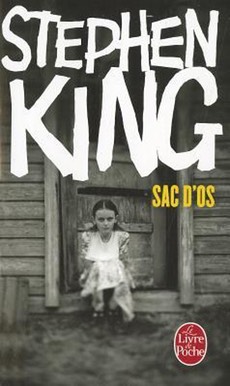 This kind of hoary melodrama requires a lot of patience from the reader, but the book starts strong, right in the middle of Noonan’s grief, and King keeps away the cliches because he really believes in his material. King’s job, and Noonan’s, is to listen to his subconscious and his dreams, and, as King says, “When an imaginative person gets into mental trouble, the line between seeming and being has a way of disappearing.” Bag of Bones is about the way the slippery subconscious wears thin the fabric of everyday life, full of hunches, sudden flashes of insight, dreams, superstitious rituals, premonitions, and quick horrific visions that turn out to be jumbled visual cues. It is, in other words, about the mental wear and tear living a life of the mind takes on a middle-aged man. As King says, “Write enough stories and every shadow on the floor looks like a footprint, every line of dirt like a secret message.” Is Sara Laughs haunted, or is Mike Noonan nuts? And if Mike Noonan, the middle-aged writer, is nuts, does that mean Stephen King, the middle-aged writer, is, too? It’s the old Rebecca plot engine gone maximum meta: is Maxim de Winter a good husband haunted by the ghost of his dead wife, or is he an insane murderer?
This kind of hoary melodrama requires a lot of patience from the reader, but the book starts strong, right in the middle of Noonan’s grief, and King keeps away the cliches because he really believes in his material. King’s job, and Noonan’s, is to listen to his subconscious and his dreams, and, as King says, “When an imaginative person gets into mental trouble, the line between seeming and being has a way of disappearing.” Bag of Bones is about the way the slippery subconscious wears thin the fabric of everyday life, full of hunches, sudden flashes of insight, dreams, superstitious rituals, premonitions, and quick horrific visions that turn out to be jumbled visual cues. It is, in other words, about the mental wear and tear living a life of the mind takes on a middle-aged man. As King says, “Write enough stories and every shadow on the floor looks like a footprint, every line of dirt like a secret message.” Is Sara Laughs haunted, or is Mike Noonan nuts? And if Mike Noonan, the middle-aged writer, is nuts, does that mean Stephen King, the middle-aged writer, is, too? It’s the old Rebecca plot engine gone maximum meta: is Maxim de Winter a good husband haunted by the ghost of his dead wife, or is he an insane murderer?
But King can’t help throwing more mysteries on the fire. Not content to have a wailing in the attic, he adds a ghostly nun in the hedge maze, a phantom sobbing in the nursery, a vampire in the crypt, and a werewolf on the moors. The central ghost story’s explanation is endless, linking to Noonan’s ancient ancestors, Sara Tidwell’s lynching, a curse that only affects children whose names start with K or C, Jo’s investigation into this curse, and on, and on, and on. When King hits a dead end in the middle of the book he has Mattie murdered in a drive-by, echoing Raymond Chandler’s old adage, “When in doubt have a man come through the door with a gun in his hand.”
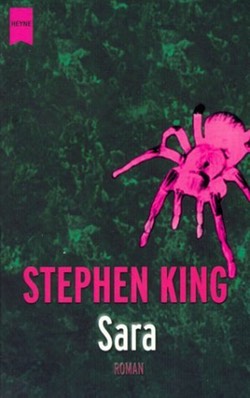 The final result is a tight, fascinating book that seems to lose its way halfway through, and then starts grabbing ideas almost at random until the final result is a gothic grown to grotesque proportions. As the review in Entertainment Weekly said, “Popular fiction doesn’t get any weirder than this.” But no matter how bizarre it gets, King can still pull off the heavy lifting. There are scenes that feel ridiculous in retrospect (a risible one in which Noonan is chased into a lake by Max Devore in a wheelchair, then pelted with stones until he almost drowns) that are completely convincing while you’re reading them due to the immediacy of King’s writing.
The final result is a tight, fascinating book that seems to lose its way halfway through, and then starts grabbing ideas almost at random until the final result is a gothic grown to grotesque proportions. As the review in Entertainment Weekly said, “Popular fiction doesn’t get any weirder than this.” But no matter how bizarre it gets, King can still pull off the heavy lifting. There are scenes that feel ridiculous in retrospect (a risible one in which Noonan is chased into a lake by Max Devore in a wheelchair, then pelted with stones until he almost drowns) that are completely convincing while you’re reading them due to the immediacy of King’s writing.
Was it worth it? Scribner went all-in on this novel, putting their imprint on the line to please a prickly, expensive author with a moribund readership, hoping they could make it grow. Certainly for Stephen King it was worth it. Bag of Bones wound up being one of King’s most well-respected novel in years, winning the Stoker Award for Best Novel, the British Fantasy Award, and a Locus Award. If you’re going to put your finger on a moment when King started gaining literary respectability, Bag of Bones was it. But was it worth it for Scribner? Was their multi-million dollar marketing plan able to raise King’s readership? Well, the book wound up selling about 1.55 million copies, which was about 200,000 more than usual, but nowhere close to Clancy’s 2.4 million. And instead of spending 14 or 15 weeks on the bestseller list? It spent 20.
Grady Hendrix has written for publications ranging from Playboy to World Literature Today and his latest novel is Horrorstör, about a haunted Ikea.










